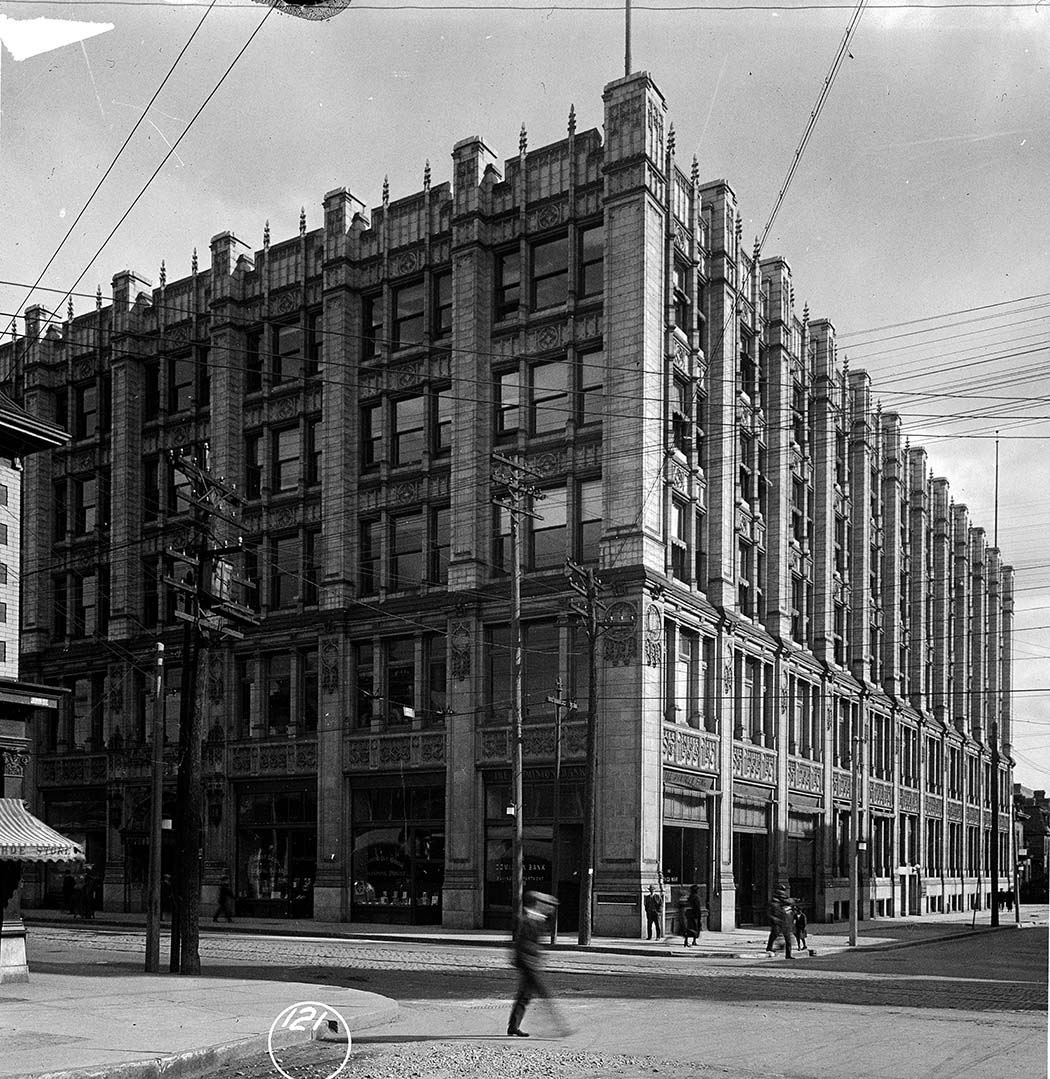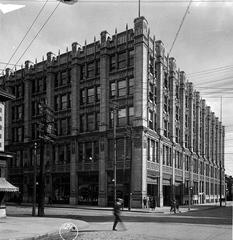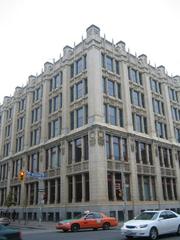
299 Queen Street West Toronto: Visiting Hours, Tickets, and Historical Guide
Date: 14/06/2025
Introduction
299 Queen Street West stands at the vibrant intersection of Queen Street West and John Street, serving as one of Toronto’s most iconic and culturally significant landmarks. From its origins as a Methodist publishing house to its legendary status as the home of Citytv and MuchMusic, the building has witnessed and contributed to over a century of Canadian religious, architectural, and media history. Today, while its interior largely remains an active media production facility and is not generally open to the public, its striking industrial Gothic façade, storied legacy, and prime location in the Queen West neighbourhood make it a must-see destination for visitors interested in Toronto’s dynamic urban culture.
This guide provides a detailed overview of 299 Queen Street West, covering its history, architectural significance, visiting hours, ticketing, accessibility, nearby attractions, and practical travel tips. For more in-depth information, consult authoritative sources such as Taylor on History, Wikipedia, and official Toronto tourism sites (Taylor on History; Wikipedia; Destination Toronto).
Table of Contents
- Introduction
- Origins and Early History
- Architectural Significance
- Evolution of Ownership and Function
- Cultural Impact and Role in Toronto’s Media Scene
- Visitor Information: Visiting Hours, Tickets, and Accessibility
- Nearby Attractions and Travel Tips
- Notable Architectural Features
- Frequently Asked Questions (FAQ)
- Conclusion
- References and External Links
Origins and Early History
299 Queen Street West was developed on land originally belonging to John Beverley Robinson and his son Christopher Robinson—figures prominent in 19th-century Toronto. The Methodist Church acquired part of this estate in the early 1900s to centralize its growing publishing and administrative operations, reflecting the denomination’s increasing influence in Canadian society (Taylor on History).
Architectural Significance
Completed in 1914 and designed by Edmund Burke of Burke, Harwood, and White, the building was originally named “The Wesley Building” after John Wesley, the founder of Methodism. Its “industrial Gothic” design features a steel skeleton clad in white terra cotta tiles, adorned with intricate Gothic and Romanesque details, including:
- Quatrefoils & Traceries: Decorative patterns reminiscent of medieval church windows.
- Figurative Sculptures: Statues of “men of learning” in monk’s robes, symbolizing knowledge and scholarship.
- Pinnacles & Crowns: Ornate details reinforcing its ecclesiastical inspiration.
- Lamps: Placed above entrances, representing the “light of knowledge.”
A major restoration in the 21st century helped preserve these unique features, securing the building’s place on Toronto’s heritage register (Taylor on History).
Evolution of Ownership and Function
Methodist and United Church Era
Upon completion, the Wesley Building became the heart of Methodist publishing in Canada. It was renamed the Ryerson Press in 1919, honoring Rev. Egerton Ryerson, and later served as the United Church Publishing House after the 1925 formation of the United Church of Canada (Taylor on History).
Commercial Transition and Media Era
In 1970, McGraw-Hill purchased the building, marking a shift to secular publishing. CHUM Limited acquired it in 1984, meticulously restoring the structure and transforming it into a vibrant media hub for Citytv and MuchMusic—a turning point that would define its legacy for new generations (Taylor on History).
Cultural Impact and Role in Toronto’s Media Scene
As the headquarters for Citytv and MuchMusic from the 1980s onward, 299 Queen Street West became synonymous with innovative broadcasting and Canadian pop culture. MuchMusic’s street-level studios and annual MuchMusic Video Awards (MMVAs) turned the building into a mecca for music fans and celebrities, with events that regularly shut down the surrounding streets (Wikipedia; That Shelf).
The building’s glass-fronted studios created an unprecedented connection between the public and the broadcast world, while installations like the “truck in the wall” (Nigel Stanley’s “Breaking News,” 1993) and the famous Speaker’s Corner booth fostered community engagement and media democratization (BlogTO).
Now owned by Bell Media, 299 Queen Street West remains a hub for Canadian media, though media operations are gradually relocating as redevelopment plans progress (blogTO).
Visitor Information: Visiting Hours, Tickets, and Accessibility
Visiting Hours
299 Queen Street West does not offer regular public tours or interior access, as it is an active media production site. The exterior can be viewed at any time, and the surrounding area is lively and safe for visitors.
Tickets and Tours
No tickets or admission fees are required for viewing the exterior. On rare occasions—such as during special media events, public tapings, or cultural festivals—limited tours or admittance may be offered. Updates about these opportunities are posted on official Bell Media channels and the building’s tour website.
Accessibility
The Queen Street West area is pedestrian-friendly, with wide sidewalks and step-free access to most nearby businesses. The 501 Queen streetcar stops directly outside, and Osgoode subway station is a short walk away. Most of the neighborhood, including the building’s exterior, is accessible for visitors with mobility needs (Miss Tourist).
Nearby Attractions and Travel Tips
Queen Street West is one of Toronto’s most dynamic neighborhoods, offering a full spectrum of attractions:
- Graffiti Alley: A celebrated corridor of urban art, ideal for photography.
- Trinity Bellwoods Park: Popular for picnics and seasonal events.
- Art Gallery of Ontario: A major Canadian art institution.
- Shopping & Dining: Independent boutiques, vintage shops, and diverse eateries line the street.
- Music Venues: The Rivoli and The Rex offer live performances.
Travel Tips:
- Use public transit to avoid parking hassles.
- Weekdays are quieter, while weekends and event days offer a livelier atmosphere.
- Check for ongoing construction or event-related street closures before visiting.
Notable Architectural Features
- North Façade: The main entrance, showcasing detailed terra cotta trim and symbolic motifs.
- Street-Level Windows: Once the stage for live MuchMusic broadcasts and fan gatherings.
- “Truck in the Wall” Installation: Nigel Stanley’s artwork symbolizes the building’s spirit of media innovation (BlogTO).
- Speaker’s Corner Booth: Formerly at Queen and John, it democratized media participation (BlogTO).
Frequently Asked Questions (FAQ)
Q: Can I tour the inside of 299 Queen Street West?
A: Public tours are rare and usually tied to special events. The building is generally closed to the public.
Q: Are tickets required to visit?
A: No tickets are needed for viewing the exterior. Tickets may be required for special events or guided tours.
Q: Is the building wheelchair accessible?
A: The exterior and surrounding sidewalks are accessible, but interior access is limited.
Q: What’s the best way to get there?
A: TTC streetcars and the subway provide easy access; parking is limited and expensive.
Q: What else is there to do nearby?
A: Explore Graffiti Alley, Trinity Bellwoods Park, the Art Gallery of Ontario, and the vibrant Queen West shopping and dining scene.
Conclusion
299 Queen Street West is an enduring symbol of Toronto’s creative spirit, bridging its religious, architectural, and media history. Although public interior access is limited due to its role as an operational media hub, its preserved industrial Gothic façade, legendary cultural legacy, and the surrounding Queen Street West neighborhood make it a rewarding destination for history, architecture, and pop culture enthusiasts. To enhance your visit, explore nearby attractions, use public transit, and watch for announcements about special events or tours on official channels.
For more updates on Toronto’s historical sites and events at 299 Queen Street West, follow Bell Media and Citytv on social media, check the official tour website, and consider downloading the Audiala app for curated local experiences.
References and External Links
- Taylor on History
- Wikipedia
- Streets of Toronto
- BlogTO
- NOW Toronto
- Destination Toronto
- CityPASS
- 299 Queen Street West Tour
- Miss Tourist
- ToDoCanada
- That Shelf
- Hot Docs




























































































































































































